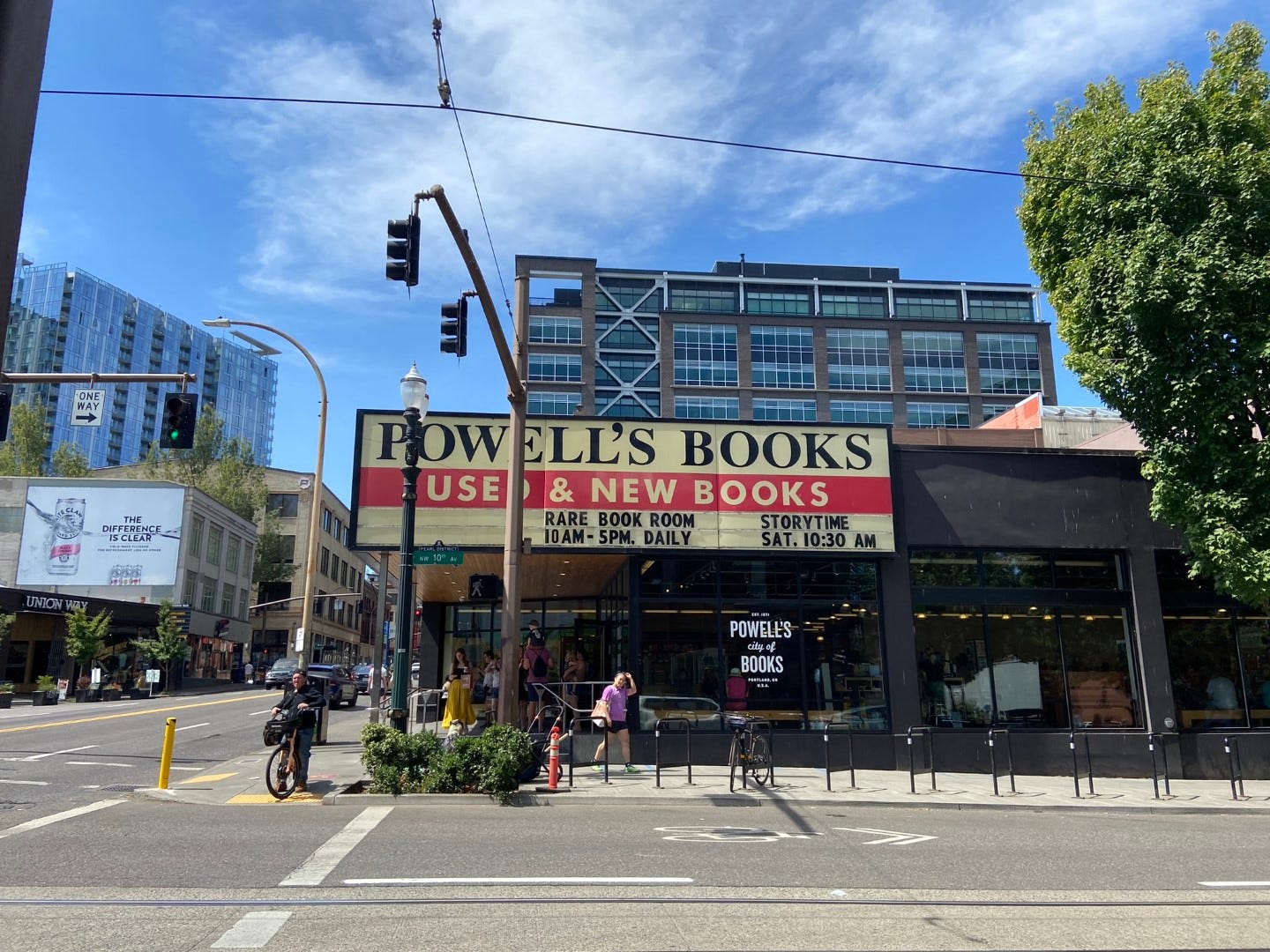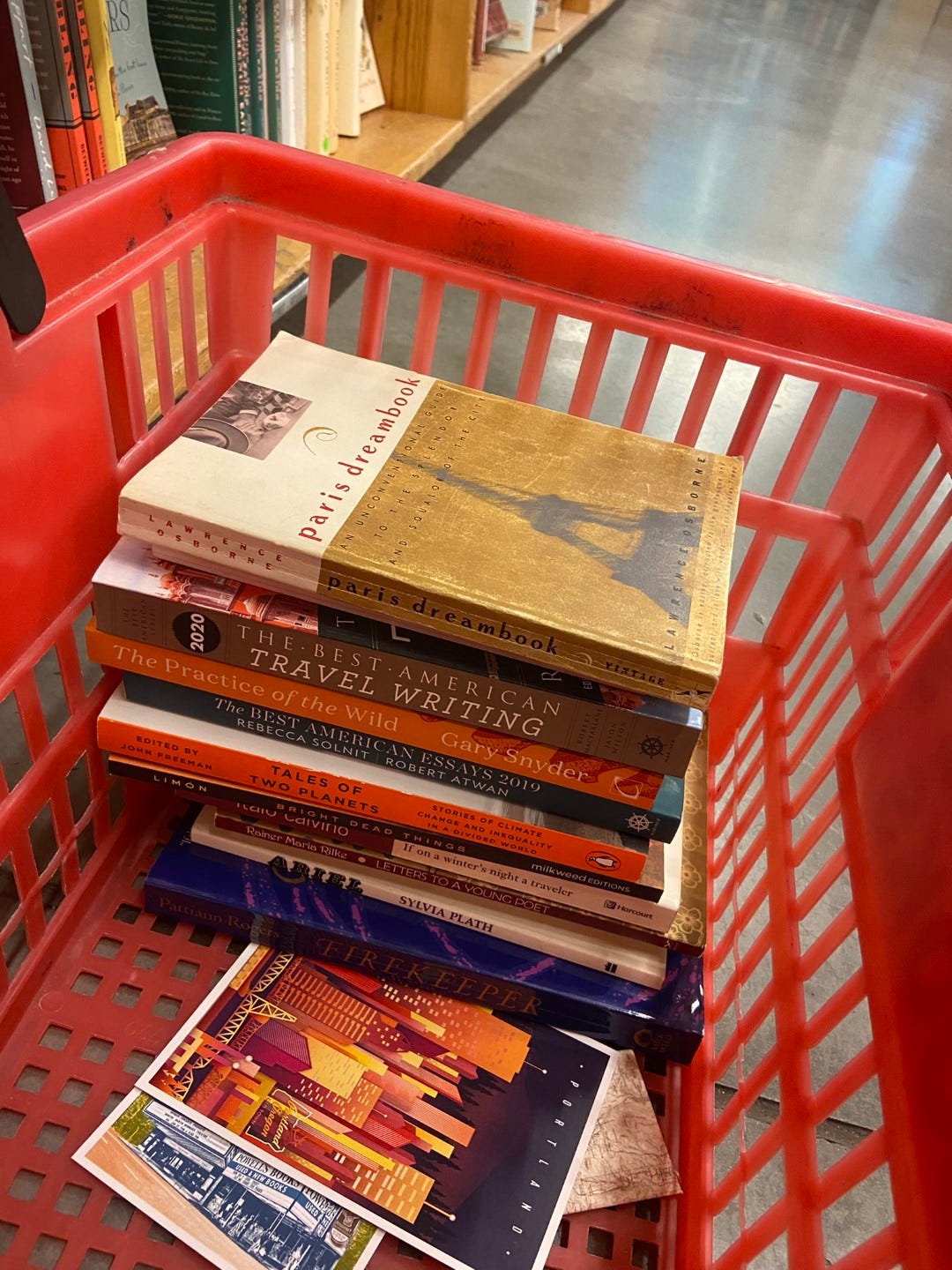You may or may not already know, dear Reader, that I am an inveterate bookworm. I was that kid who read fantasy books at recess and Pride and Prejudice during pep rallies (true story). I took a hiatus from this status as an oversubscribed undergrad, but once I started graduate school in a system with basically no deadlines until THE deadline, the haze cleared from my eyes and I remembered who I was. Now I read roughly a book a week.
It’s not only the act of reading I crave; it’s books. I’ve become someone who reads book newsletters and my goodreads feed1 with almost as much relish as the content of said books. I will talk about books with anyone who wants to talk about books. I gravitate to any bookstore in my vicinity. Call it the intoxication of surrounding myself with skeins and skeins of latent stories, sifting through them, seeing what calls, and imagining gathering all those sparkling and brooding worlds into my own.
So, when I visited Portland last month, I had a sacred pilgrimage to make. Portland is home to Powell’s Books, the world’s largest independent bookstore,2 and I budgeted at least half a day to visit.
I had been there once before, when I was in college and slightly less rabid. I certainly appreciated the wow factor of a whole city block’s worth of crowded shelves, and drifted through the color-coded rooms with appropriate bookish awe. But I wasn’t honed for it in the way I am now. That first time, I hadn’t psyched myself up for a marathon of perusal and absorption, and didn’t stay more than an hour. This time, I stayed for seven hours.
Powell’s—also styled as Powell’s City of Books—is situated at the edge of downtown Portland, without any more fanfare than cleanly lettered, red-bannered signage at each corner, with the look of something that hasn’t been updated since the 70s because it doesn’t need to be: it’s that iconic. Simple marquees over the main entrance announce author talks and book signings. When I visited, happily for this bastion of independent booksellers, people were streaming in and out.
Hour 1
I was off to a bit of a rocky start when, a few minutes after stepping inside, I realized I hadn’t eaten lunch. I couldn’t do this without fuel, but I had already picked up a red grocery-style shopping basket and couldn’t really imagine leaving. So I chose a graphic novel and ordered lunch at the café inside Powell’s. I read the entire thing over my mediocre mac and cheese. And then put it back on the shelf. No one objected.
Hour 2
Browsing began in earnest in the Blue Room, in the Poetry section. With limited transatlantic book-lugging space weighed against limited opportunities to buy English-language books back in Grenoble, I had to strategize. I skipped the shiny bestsellers. I was looking for books best read in paper—like poetry—and books I hadn’t been able find in digital form.3 And perhaps some wild cards: Powell’s real strength is its dragon’s hoard of used books mixed in alphabetically with the new. Discovery awaits!
In Poetry, I found some vintage Plath, some creased Rilke, some dog-eared Pattiann Rogers (a science-minded nature poet I love), and then realized I had spent an hour in P-R alone. In the meantime I listened to a mother try to placate a gloweringly silent teenage son who had apparently imagined disdain in his sister’s question, “What’s that book about?” and had promptly put it down. It was a book of love poetry.
Hour 3
Still in the crowded front-of-store aisles of the Blue Room, I wove through Literature A-C and found Italo Calvino in translation. I also ended up with a 1993 copy of Wide Sargasso Sea with the most comically horrendous book cover I’ve ever seen, let alone owned. It was only $7.
In my browsing, I was often waylaid by the handwritten Staff Pick notes taped to the shelves, which you can find lovingly scrawled in any section of the store, even where most of the books are floppy and lean across gaps. Little call-outs like these help cut through the clamor of voices and minds and places catching at your skimming mind’s-eye. Crouching to sample a title that manages to make itself heard, you transition from skittery grazing to tunnel vision. A border crossing in Palestine, perhaps. You lose track of time. When you stand up again your legs have gone sourly numb in a way you’ve never quite felt before, and your eyes are stiff. Then it’s back to the slow shuffle, neck craning, feelers out.
By the time I circled back to the essay collections and agonized for many minutes over which annual Best American Essays collection to choose out of several decades’ worth, I was losing steam. But there were still five colors of rooms I hadn’t seen. I decided to at least do a little tourist-style sweep of them.
Hour 4
In the Rose Room, I found a prequel to my favorite childhood comic book series (Bone by Jeff Smith) that I’d never seen before. I stood there and skimmed the whole thing. Somehow, this gave me a second wind.
Hour 5
Upstairs is the domain of non-fiction. I’ve always found it curious that by virtue of being easily categorized, non-fiction balloons into dozens more genres and subsections and shelf space than “literature” ever does. Are there actually more non-fiction books written about anthropology and metaphysics than works of fiction encompassing these topics? I don’t know.
In any case, I wove through the Purple Room past the impressive collection of tarot cards opposite the Metaphysics shelf, and into the Red Room where I was snagged by the Travel section. I learned that 95% of France travel writing is about Paris. I chose a unicorn, the promisingly weird paris dreambook by Lawrence Osborne, to take home. I passed by Languages and heard a family speaking what sounded like Russian, and they were indeed perusing the Russian shelf. I was a little too far gone to look at French.
Hour 6
I finally alighted in the Nature aisles, my home even more than Travel. Here there be scientific monographs mixed with field guides and memoirs, shelves for incredibly specific taxa (canines, ungulates), and a marine section with a distinctly blue aura. Also an Ecuadorian birdwatcher who noticed my attention to the bird books and showed me photos of hummingbirds feeding from his hand, and of the red van he and his companions had driven from Ecuador to Portland over the last 17 months.
It’s calmer up here; the only real noise is the intercom with messages from color-coded info desks that, after enough hours, make you feel companionably part of the life of store. But non-fiction clamors in a different way than fiction. Here, issuing from featured shelves and declarative covers, comes pitch after pitch after pitch, messaging, politics, answers. The Future is Analog. This Changes Everything. Outlive. Fiction marketing admittedly works more or less the same way, but in a more intuitive register. The non-fiction blurbs invite your analytical brain onto a hamster wheel—while still aiming for the gut.
Hour 7
As evening fell, I remembered a list of books about street art and graffiti that I wanted to look for (research for a future newsletter that I feel inadequate to write without more context). I went to the nearest info desk, where a mild-mannered man in a graphic tee typed the titles into the database search. It turns out Powell’s doesn’t have every book in existence, but they did have two of the titles. One, The Faith of Graffiti by (the) Norman Mailer, turned out to be an antique worth over $100, locked away in the Rare Books room. I could have gotten a look at it if the Rare Books room hadn’t already closed for the day, alas. The other (Subway Art by Martha Cooper) was in an Arts aisle endcap featuring street and body art, up one more floor in the Pearl Room.
So I spent my last hour in the Pearl Room, kneeling to peruse coffee table books about graffiti. These included one featuring a mural in Grenoble, and another in French, after all. I chose a compact introduction to take with me. (Stay tuned…)
As I cast a last poignant glance around at the photography and sociology and history books beyond my remaining bandwidth, I heard someone on his way out declare, “I’m going to drive all the way back here to come to this corner of this bookstore to finish the book about Obama.” He could have been joking, but his tone seemed earnest—and I could entirely sympathize if he was serious. Powell’s comes close to a literal embodiment of the promise of books: the whole world, almost, stacked within your reach. If only you weren’t so finite. But if you keep coming back, if you keep reading, perhaps you can simulate the infinite.
P.S. Reader, I bought them. After painfully shedding a few books, I kept within a $120 and 15 lb budget. I was rung up, coincidentally, by the nice man from the Red Room info desk. He gave me lots of bookmarks. Luckily, I still had a carryon allowance free for my new canvas Powell’s bag full of books.
Let’s be goodreads friends :) Here's my profile
There are other contenders, but when considering independent status and sheer number of new + used books (over 1 million) rather than floor space, Powell’s is a clear winner.
As much as I appreciate books as objects, I’m format agnostic; I want the content. And audiobooks have probably allowed me to quadruple my reading capacity. But there are exceptions.










That's an amazing marathon! I'm imagining the discipline of buying books by weight. A beautiful French poem for you: http://www.ipoesie.org/automnemaladeetadore
So fun to read this , Anne! As you described the way you cast your net, I recognized it as a method I've inadvertently adopted. Fiction, non-fiction, biography, essays; there's great possibility in it all. You make a good point or two about the way different genres grab your attention--or not. (I'm not much for mystery's or romance). I think I'd like sci-fi more if I knew how to negotiate the vast offerings. But in general I walk all the aisles and shoot from the hip. You never know what you'll find! 😀